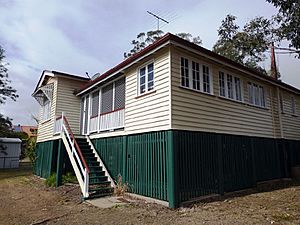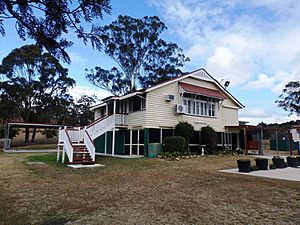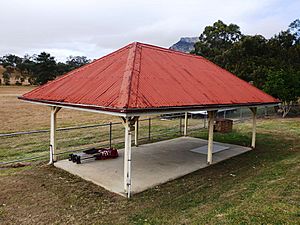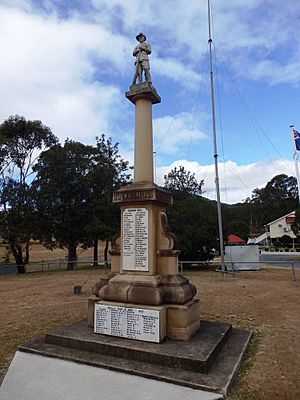Maroon State School and Maroon War Memorial facts for kids
Quick facts for kids Maroon State School and Maroon War Memorial |
|
|---|---|
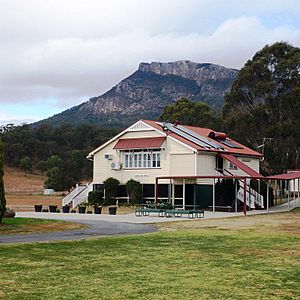
1938 teaching building with Mount Maroon in the background, from NW, 2015
|
|
| Location | 2772 Boonah Rathdowney Road, Maroon, Scenic Rim Region, Queensland, Australia |
| Design period | 1914–1919 (World War I) |
| Built | 1910, 1937–1938, 1937 |
| Official name: Maroon State School and Maroon War Memorial | |
| Type | state heritage |
| Designated | 9 October 2015 |
| Reference no. | 650004 |
| Type | Education, research, scientific facility: school – state (primary) |
| Theme | Creating social and cultural institutions: Commemorating significant events; Educating Queenslanders: Providing primary schooling |
| Lua error in Module:Location_map at line 420: attempt to index field 'wikibase' (a nil value). | |
The Maroon State School and Maroon War Memorial is a special place in Maroon, Queensland, Australia. It includes a school and a memorial built to remember soldiers. The school first opened in 1891. The whole site was added to the Queensland Heritage Register on October 9, 2015, because of its important history.
Contents
A Look Back: History of Maroon School
Maroon State School is located south of Boonah, close to the border with New South Wales. It started as Maroon Provisional School in 1891. A "provisional school" was a school set up by the local community. The government would help pay the teacher.
In 1898, the government took over the school. It officially became Maroon State School in 1909. Over the years, new buildings were added. A playshed was built in 1910. A house for the teacher was built in 1937. The main school building was replaced in 1938.
The school grounds are surrounded by old trees. The war memorial, built in 1920, stands at the front. From the road, you can see the memorial, then the school, with Mount Maroon in the background. The school has been open non-stop since it began. It has always been a key place for the local community.
Early Days in Maroon
European settlers first came to the Maroon area in the 1840s. Farming began around 1870. More people moved here from 1887. They farmed dairy, pigs, and crops like corn. Timber cutting was also a big industry.
By 1887, Maroon had two shops. A creamery opened in the 1890s. A School of Arts, a community hall for learning and events, was built in 1903–04. Churches were also built in the early 1900s.
Why Schools Were Important
Starting a school was very important for new communities. Local people often gave land and helped build the school. Schools became a symbol of progress and a source of pride. They connected people, including past students and teachers. War memorials and community halls often added to these connections.
The Queensland Government created standard plans for school buildings. This made building schools easier and cheaper. Most schools from the 1860s to the 1960s were made of timber. These designs were updated over time. Queensland schools were known for their smart ways to control climate, light, and air.
Building Maroon Provisional School
The Maroon community worked hard to open their school. A committee was formed in January 1891. They donated materials and built the school themselves. It opened on July 15, 1891, without costing the government anything. The building was also used for meetings, church services, and as a library.
The land for the school was given by Thomas de Montmorenci Murray-Prior. He was the committee chairman. The land was given to the Crown in 1898. That's when the government took over the school.
The first school building was small. It soon became too small for all the students. By 1906, there were 54 students. The school was made bigger in 1907. The community paid part of the cost. By 1908, the school bell was on a wooden stand outside.
Becoming a State School
In 1909, Maroon Provisional School became Maroon State School. The government lowered the number of students needed for a state school. This meant many provisional schools became state schools.
The Playshed
In 1910, a playshed was added to the school grounds. Playsheds were important because schools often cleared all trees. They gave students a covered place to play in any weather. They could also be used for teaching. Playsheds were common at Queensland schools from the 1880s to the 1950s.
The playshed at Maroon was 24 by 12 feet. It had a hip roof and was made of timber. It cost £49 to build. It had six posts and seats on the longer sides. A water tank was added the next year.
New Buildings for the School
In 1917, the school committee asked for a new teaching building. The old one was too narrow and leaked. Instead, the roof was fixed in 1924. Larger windows were added later.
Finally, in 1938, Maroon State School got a new teaching building. It was a standard timber design. This type of building was built for a set number of students, like 24, 40, 60, or 80. The new building for Maroon was for 60 students. It was finished in late 1937 and opened on January 24, 1938.
The 1937 plans show a single room building. It was made of timber and raised high on stumps. It had a gabled roof and verandahs on the east and west sides. The classroom was 18 by 30 feet. Stairs led to the verandahs. Hat rooms were at the ends of the verandahs. Windows were on the north and south walls. The under-school area was used for play.
The Teacher's Residence
By the time the new school building was ready, the teacher had a new house. It was built in 1937. Most Queensland state schools had a teacher's house, especially in country areas. This was to help attract teachers to rural places.
The teacher's house at Maroon was a typical design from the 1930s. It was a raised timber house with a hipped roof. It had an L-shaped verandah. Inside, it had three bedrooms, a living room, kitchen, and bathroom.
School Grounds and Trees
School grounds were very important in Queensland. They had outdoor play areas and sports fields. Trees and gardens were planted for shade and beauty. Arbor Day celebrations, where trees were planted, began in Queensland in 1890.
Maroon State School has many old trees. Students planted fruit trees and other types of trees over the years. These included silky oak, camphor laurel, and jacaranda trees.
Maroon War Memorial History
The Maroon War Memorial was built in 1920. It honors the men from the Maroon area who served in World War I (1914–1918).
Maroon was a small farming community during the war. Forty-two men from the district joined the army. Seventeen of them died. This was a very high number for the community.
After the war, many memorials were built across Australia. They showed a nation's thanks and sadness. In 1919, a local committee formed to raise money for a memorial in Maroon. They asked to put it in the school grounds.
The memorial was designed by F Williams & Co., a company from Ipswich. Frank Williams, the founder, designed many war memorials in Queensland. The Maroon memorial has a "digger" statue on top of a tall column. It is made of sandstone with marble plaques. It stands 17 feet 6 inches tall.
General Sir William Birdwood, who led Australian soldiers in the war, unveiled the memorial on May 21, 1920. He also gave medals to 14 local soldiers who returned.
Later, a marble plaque was added to the memorial. It honors the 42 men and women from the district who served in World War II. The Maroon War Memorial is still used for annual Anzac Day ceremonies.
In 1991, a time capsule was placed at the base of the memorial. This was to celebrate 100 years of Maroon State School.
Changes Over Time
The Maroon area is still mostly farming. So, the school has not changed much over the years. In 1955 and 1970, photos show the school had the teacher's house, playshed, and the main school building. It also had a tennis court.
Over time, parts of the teaching building's verandah were enclosed. Air conditioning was added. The playshed was moved to its current spot by 1961. The old wooden posts were replaced with metal ones.
New buildings have been added to the grounds since 2006. In 2011, a new library building was built. As of 2025, this new building is used for teaching. The old timber school building is now used as a library and for offices. The Maroon War Memorial is still a main spot for Anzac Day events.
What You Can See: Description
Maroon State School is on a large, rectangular piece of land. It is in a rural area, surrounded by fields, at the foot of Mount Maroon. The main road forms the northern edge. The War Memorial is in the northeast corner, near the entrance.
The school buildings are set back from the road. The Teacher's Residence (1937) is in a fenced yard in the southwest. The main teaching building (1938) is to the east. The playshed (1910) is southeast of the teaching building. The grounds have open lawns and old shade trees.
Teacher's Residence (1937)
The teacher's house is made of timber and covered with weatherboards. It is raised high on concrete stumps. It has a hipped roof with a gable at the front. There is an L-shaped verandah that has been enclosed. Stairs lead to the front verandah.
Inside, the house has three bedrooms, a living room, kitchen, and bathroom. The kitchen still has its old stove area. The walls and ceilings are lined with timber boards.
The area under the house has a concrete floor. It is enclosed with timber screens. A laundry room is in the southeast corner. Old metal water tanks on timber stands are next to the house.
Small Timber School Building (1938)
This teaching building is also made of timber and covered with weatherboards. It is raised high on stumps. It has a gabled roof. The north and south walls have large windows. These windows have fanlights above them and sunshades.
The classroom walls and ceiling are lined with timber boards. The ceiling is curved and has a metal rod across it. It also has a decorative vent. The verandahs on the east and west sides have been enclosed. They have timber stairs. The old school bell hangs near the western door.
The area under the building has a concrete floor. It is enclosed with metal sheeting and screens. A storage room is in the southwest corner.
Playshed (1910)
The playshed is a small timber structure with six posts. It has a hipped roof covered with metal sheeting. The posts are braced to the roof. The posts now sit on a concrete slab. The original timber seats have been removed.
Grounds and Views
The school grounds are on a slope. The open lawns, trees, and gardens make the school look very nice.
There is a large hoop pine tree near the northwest corner. Other old trees are around the grounds. Jacaranda trees are also present.
The school complex looks beautiful from the road. It is set against the backdrop of Mount Maroon. You can also see lovely views of the countryside and Mount Maroon from inside the school grounds.
War Memorial
The Maroon War Memorial is inside a small fenced area at the school. It is a tall structure. It has a sandstone base, a column, and a "digger" statue on top.
The base has two levels. It has marble plaques with names on them. The front plaque lists the 42 local men who served in World War I. Below this, another plaque lists the 42 local men and women who served in World War II. The back plaque says the memorial was built by Maroon residents to honor those who served in World War I.
Other small plaques mention that General Sir William Birdwood unveiled it in 1920. Another plaque notes a time capsule placed in 1991 for the school's 100th birthday.
The top of the base has the words "King & Empire". Above this is a plain column. On top of the column is a statue of an Australian soldier, called a "digger". He stands in a relaxed pose.
Inside the memorial area, there is a concrete path and some trees. Two small trees, possibly cypress, stand on either side of the path. A tall metal flagpole is behind the memorial. Mount Maroon in the distance makes a dramatic background.
Why This Place is Important
Maroon State School and Maroon War Memorial are important for many reasons. They show how education and community life have changed in Queensland.
The school buildings are good examples of government designs. The teacher's residence (1937) shows how the government provided homes for teachers in rural areas. The small timber school building (1938) shows how school designs improved for light and air. The playshed (1910) and the large grounds with trees show how important play and beauty were in education.
The Maroon War Memorial (1920) shows how the school community was involved in a major world event. Its size shows how much the district lost. War memorials honor those who served and died. This memorial also shows the work of Frank Williams, a famous stonemason.
Maroon State School is a good example of a small, regional school. The teacher's residence is a good example of a home from that time. The teaching building is a good example of its type, with its gable roof, old windows, and verandahs. The playshed is also a good example of its kind.
The school and memorial are beautiful to look at. They are set against Mount Maroon and surrounded by fields. This mix of nature and buildings in a quiet rural area is very picturesque.
Schools are always important to communities. They connect past students, parents, and teachers. They are places for social events and volunteer work. Maroon State School has a strong connection with the Maroon community. It was started by the community in 1891. Many generations of children have learned there. It is a key gathering place for the community.
The Maroon War Memorial is important to the community for social and spiritual reasons. It reminds them of a major historical event. It is the main place for annual Anzac Day ceremonies.


